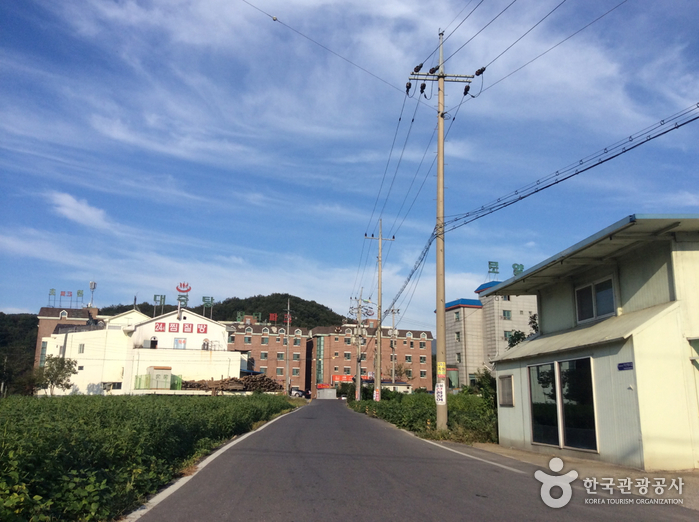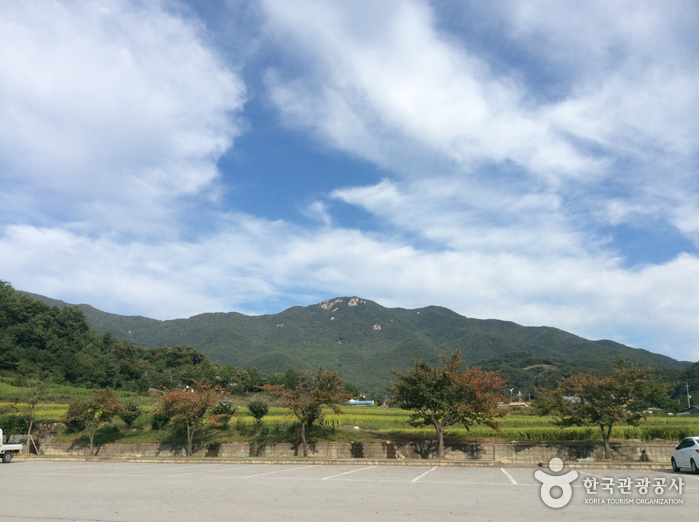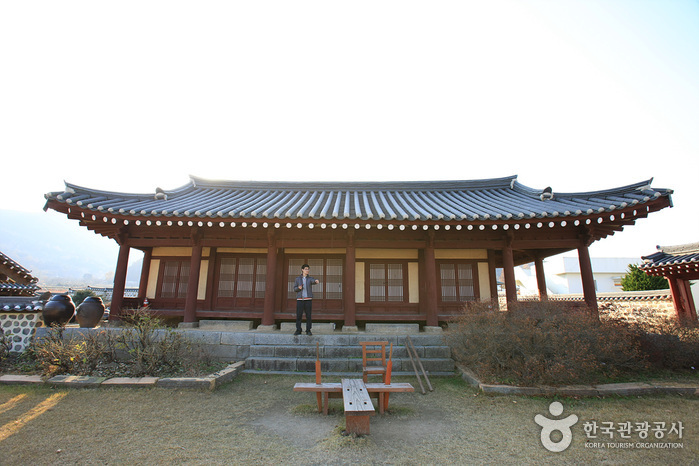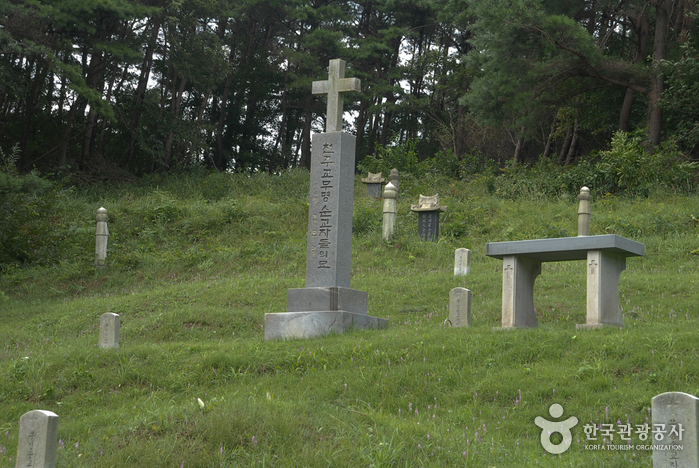Gaya Tourist Hotel (가야관광호텔)
14.2 Km 11456 2020-04-14
14, Sinpyeong 1-gil, Yesan-gun, Chungcheongnam-do
+82-41-337-0101
Gaya Tourist Hotel, located in Doeksan Provincial Park, is surrounded by the beautiful forests and clean waters of Gayasan and Doeksungsan mountains.
The hotel has cozy rooms and other convenient facilities such as a coffee shop, restaurant, fitness club, souvenir shop, and a sauna that uses natural hot springs water (45℃) from 602 meters underground. Due to its famous spa, the Gaya Tourist Hotel is a well-known tourist spot on the west coast and is mainly frequented by family visitors.
Namdang Port (남당항)
14.2 Km 15674 2024-06-05
Namdang-ri, Hongseong-gun, Chungcheongnam-do
+82-41-630-1224
Namdang Port is a representative port on the West Coast. Known for having plenty of prawn, cockle, flat fish, rock fish and other types of seafood, the port draws visitors all year round. Cockles in particular are a local delicacy, usually enjoyed as cockle shabu shabu or charcoal-grilled cockle. A nearby attraction to visit is the bamboo grove of Jukdo Island
Deoksan Hot Spa District (덕산온천지구)
14.2 Km 21561 2020-05-27
Deoksan-myeon, Yesan-gun, Chungcheongnam-do
+82-41-339-7303
Deoksan Hot Spa is conveniently in Sadong-ri, Deoksan-myeon, Yesan-gun, Chungcheongnam-do, only one and a half hours away from Seoul. The spa resort’s hot springs have been known for their efficacy ever since the Joseon dynasty (1932-1910) and the 45℃ germanium water is widely known for its health benefits. The region has been home to major spa resorts since 1917.
Nearby tourist attractions include Chunguisa Temple, which enshrines the spirit of Patriot Yun Bong-Gil, and Sudeoksa Temple, a training site for Buddhist nuns. Within the spa district are 9 major spa facilities, approximately 50 hotels, and numerous restaurants.
Cheonbuk Oyster Complex in Boryeong (보령 천북굴단지)
14.3 Km 35138 2024-06-05
Cheonbuk-myeon, Boryeong-si, Chungcheongnam-do
+82-41-930-0804
Cheonbuk Oyster Complex in Boryeong is a place near the Hongseong Embankment where various restaurants specializing in oysters are clustered. Boryeong is known for its abundant oyster production, with those caught between November and February considered the finest. In December, the Cheonbuk Oyster Festival is held, featuring events for tourists. Here, visitors can taste a variety of dishes made with oysters, including grilled oysters, raw oysters, and oyster rice.
Seosan Gayasan Mountain (가야산(서산))
15.0 Km 39486 2022-11-17
Sansu-ri, Seosan-si, Chuncheongnam-do
+82-41-662-2113
Gayasan Mountain has easy and enjoyable hiking trails connecting Gayabong Peak, the main peak, with other peaks and mountains, namely Wonhyobong Peak (677 m), Ogyangbong Peak (621.4 m), Illaksan Mountain (521.4 m), Sujeongbong Peak (453 m), and Sangwangsan Mountain (307.2 m). The trails are as easy and suitable for all hikers including the elderly and young hikers. A distant view of the west sea is even visible from the top of the mountain. Gayasan Mountain offers amazing scenery all year round, most notably in spring when azaleas, royal azaleas, and an array of wildflowers are in full bloom.
The mountain also contains the Seosan Rock-carved Buddha Triad (National Treasure), which is considered the best rock-carved Buddha from the Baekje period. The mountain is also home to Bowonsa Temple Site, Gaesimsa Temple, and Illaksa Temple. With one National Treasure, six Treasures, and four cultural heritages preserved on the mountain, it is safe to say that Gayasan Mountain is the heart of Naepo Culture Zone (northwestern region of the province of Chungcheongnam-do), making the entire mountain a cultural asset.
Daeheung Dongheon (대흥동헌)
15.0 Km 3953 2021-05-25
33, Uijoeunhyeongje-gil, Yesan-gun, Chungcheongnam-do
+82-41-339-7332
"Dongheon" refers to the administrative building or headquarters for the top city official of the Joseon dynasty. This tile-roofed house measures six kan (traditional Korean measuring unit), or approximately 14.4 meters, on the front, two kan (4.8 meters) on the side and is 3.3 meters in x_height. Records carved on its gate show that the wooden house was constructed in 1407. The house, which is characteristic of late Joseon dynasty architecture, was once used as Daeheung-myeon office, but was dismantled and restored to its original appearance in 1979.
Cheongyang Daracgol Julmudeom Holy Site (청양 다락골 줄무덤 성지)
15.2 Km 8051 2020-06-25
78-6, Darakgol-gil, Cheongyang-gun, Chungcheongnam-do
+82-41-943-8123
Julmudeom refers to the unmarked graves of anonymous Catholic martyrs in Darakgol, Cheongyang in Chungcheongnam-do. Darakgol is also the birthplace of St. Choi Gyeong-hwan and Choi Yang-eop (the second Catholic priest in Korea) was also martyred in Gwacheon, Gyeonggi-do. Because the grave is of more than one individual, it was given the name Julmudeom (group graveyard).
Although the exact number of martyrs and their exact cause of death is unknown, they were buried by family resulting in the 37 mounds in three sections. In 1982, Cheongyang Cathedral established monuments to commemorate the unidentified martyrs, and Julmudeom became a well-known site for Catholic pilgrimages. In 1986, the remains of St. Choi Gyeong-hwan Francisco were relocated to the Jeoldusan Martyrs’ Shrine reducing the total number of mounds at Julmudeom to 36.
Boryeong Eunhaeng (Ginkgo) Village (보령 은행마을)
16.3 Km 2247 2015-01-20
150-65, Oseosan-gil, Cheongna-myeon, Boryeong-si, Chungcheongnam-do
+82-70-7845-5060
In Boryeong-si, Chungcheongnam-do, Boryeong Eunhaeng (Ginkgo) Village is filled with ginkgo trees. It is also called “Cheongna Eunghaeng Maeul” (청라 은행 마을) and “Green Rural Tourism Village” (녹색농촌체험마을).
Upon entering the village, murals can be seen, which are enhanced by ginkgo trees throughout the village, particularly in autumn when they change a dazzling yellow.
The village uses Janghyeon Elementary School, which closed in 1991, as a market place and local experience venue. Permanent hands-on programs and seasonal countryside activities, making a mosaic with ginkgo leaves, and shaking and gathering ginkgo leaves are also available.
Seokhwachon (Boryeong) (석화촌(보령))
16.6 Km 5962 2024-02-26
15 Bakgangsul-gil, Jupo-myeon, Boryeong-si, Chungcheongnam-do
041-932-9005
Seokhwachon is a traditional Korean restaurant converted from a rural house. It specializes in Korean dishes. The menu includes specialties such as hanbang ori baeksuk (whole duck soup with medicinal herbs), hanbang dak baeksuk (whole chicken soup with medicinal herbs), samgyetang (ginseng chicken soup), saengseon gui (grilled fish), and galchi jorim (braised cutlassfish). The restaurant offers a variety of dishes that are both hearty and refined, combining sincerity and homemade flavors. Boasting a location where mountains and sea coexist, Boryeong offers diverse ingredients, and it hosts the Boryeong Mud Festival annually in July.
Hanil Sikdang [Sapgyo, Yesan] (한일식당[예산 삽교])
16.6 Km 1882 2024-02-21
58, Sapgyoyeok-ro, Sapgyo-eup, Yesan-gun, Chungcheongnam-do
Hanil Sikdang has served someori gukbap (beef head meat and rice soup) in front of Sapgyo Station for nearly 70 years. Someori gukbap (beef head meat and rice soup) is a soup boiled with beef head meat, beef offal, radish, and dried radish leaves, using a broth simmered with beef head and bones. The soup is kept boiling in a massive cast iron pot all day long. When a bowl is ordered, the soup is ladled into a hot pot and garnished with meat and green onions. The someori gukbap (beef head meat and rice soup) here is slightly spicy.





![Hanil Sikdang [Sapgyo, Yesan] (한일식당[예산 삽교])](http://tong.visitkorea.or.kr/cms/resource/18/3056018_image2_1.jpg)
 English
English
 한국어
한국어 日本語
日本語 中文(简体)
中文(简体) Deutsch
Deutsch Français
Français Español
Español Русский
Русский